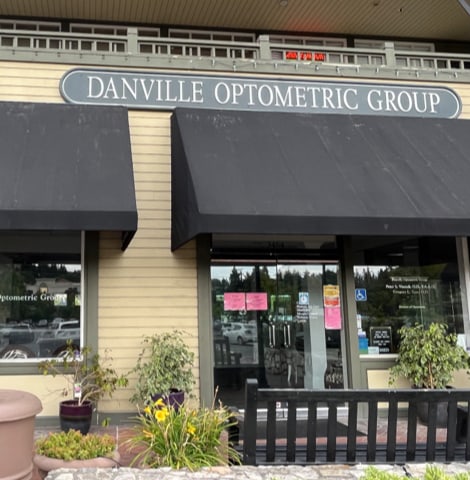There are many different eye diseases and conditions that could affect your eye health or vision. Age-related macular degeneration (AMD) is one disease in particular that is the leading cause of blindness in older adults. AMD often begins with little to no symptoms, but one may notice central vision blurriness and trouble seeing in low light as the condition progresses.
Once central vision is lost due to AMD, it cannot be recovered, so it is important to get regular comprehensive eye exams as recommended by your optometrist. That way, your eye doctor can advise you on how to minimize vision loss by preventing intermediate dry AMD from turning into late AMD.
What Is AMD?
AMD is typically an age-related eye disease, as the name suggests. The eye’s macula, which is responsible for your central vision, sustains damage over time. Although AMD won’t cause complete blindness because it only affects your central vision, it can make it extremely difficult to perform daily tasks like driving, seeing up close, or recognizing faces.
Types of AMD
There are 2 primary types of AMD—dry and wet. Dry AMD is broken up into several stages.
Dry AMD
Most cases of AMD are dry AMD. This form of the disease happens as the macula thins with age. There are 3 stages of dry AMD: early, intermediate, and late. This progression typically takes place over several years, and many people do not notice the subtle changes in their vision until the intermediate or late stages.
One thing worth noting is that there is no treatment for late dry AMD. Treatments like vision therapy or taking precautions to protect the other eye if only one eye is affected by the disease are common at this stage.
Wet AMD
Wet AMD is less common and always a late-stage AMD. One difference is that there are treatment options available for wet AMD. But unfortunately, vision loss typically occurs much faster with this form of AMD. The primary cause of wet AMD is the formation of abnormal blood vessels in the back of the eye, which damage the macula more quickly than the regular thinning with age.
Early Signs of AMD
There are typically no warning signs of AMD during early dry AMD. Blurriness in your central vision and difficulty seeing with low light could be present during intermediate dry AMD. There is no treatment for AMD, but your eye doctor may recommend lifestyle changes or dietary supplements to prevent intermediate AMD from turning into late AMD.
You may notice lines beginning to look wavy or crooked, the central vision blurriness may increase and include blank spots, and colors may seem less bright with late dry or wet AMD. The vision loss associated with intermediate or late AMD cannot be recovered.
Preventing AMD
There is not a single way to prevent AMD. And you can’t simply avoid getting older to prevent the most significant risk of an age-related disease. But there are a few things you can take action on to help lower your risk of developing AMD—along with other eye diseases or conditions.
Benefits of Wearing Polarized Sunglasses
Ultraviolet light (UV) could increase the risk of developing AMD. So, wearing polarized sunglasses that block 100% of UVA and UVB—two dangerous forms of UV light—is a great way to lower your risk from this source. An anti-glare coating, in addition to the UV protection, can help reduce the discomfort from heightened sensitivity if you are already developing AMD. Dark sunglass lenses does not mean adequate protection. In fact, it exposes more of the lens and retina to more harmful UV light because it dilates the pupil. Better quality equals better protection. Name brand manufacturers are held to a higher standard and are regulated. UV protection also wears out over time. So updating your sunglasses is critical to long term eye health to avoid macular degeneration and cataracts.
It’s also worth mentioning that other eye conditions, such as cataracts and eye cancers, have also been linked to UV exposure.
Lifestyle Changes
Smoking is linked to an increased risk of developing AMD—not to mention the other negative health effects that accompany smoking. So, quitting smoking is a significant way that you can lower your risk of developing AMD.
Also, simply living an active lifestyle and keeping your health in check with regular activity, regular eye exams, and paying attention to your overall health can reduce your risk of developing AMD.
Healthy Diet
A healthy, balanced diet is important for many areas of our health. But research specifically links certain nutrients like lutein and zeaxanthin to increased macula health. These are found plentifully in dark-green leafy vegetables like spinach, kale, or collard greens.
Discuss Your Vision with Us
There is ultimately no way to guarantee that you will never develop a condition like AMD. But there are certain steps you can take to help lessen the risk. It’s also wise to include your eye doctor in your prevention efforts. Not only can they offer advice on taking care of your eyes, but they can potentially detect conditions and diseases in their early stages.
Give us a call to schedule an appointment if you’re due for your next eye exam, and let us know if you’re experiencing any of the symptoms of intermediate or late AMD. We have special equipment such as Optical Coherence Tomography, Ultrasound, Fundus photography, and infrared filters to observe early retinal changes.













